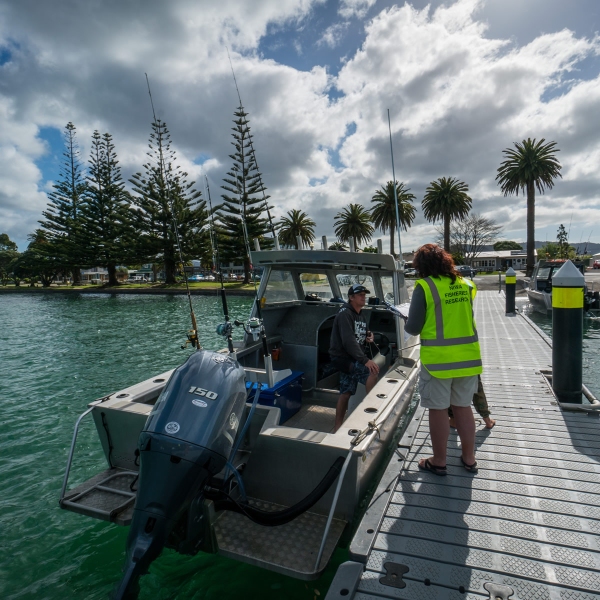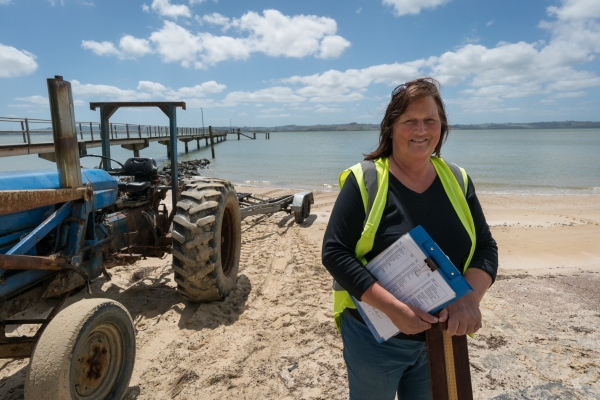Kim McNamara says she can tell if someone’s had a bad day fishing just by looking at them.
“You almost become a fishing psychologist – you can tell by the way people walk up the ramp to get their trailer if they’ve had a good day.”
For the past two years Kim has been working as a ramp interviewer for NIWA at Shelly Beach, near Auckland. On a typical day she’ll interview 40 groups of people returning from a day’s fishing, finding how many and what kind of fish they’ve caught, where they’ve been, the bait they’ve been using and how long they’ve been out for.
She’ll measure the catch, record the data and also ask what they threw back.
“That’s the really interesting one – it’s when the shark stories come out and the tales about the ones that got away.”
The job, she says, is surprisingly social.
“Lots of people love to chat, they love to show you their catch and sometimes you see some amazing fish and other things they have fished out the sea. Sometimes they question why you weren’t there last time and proceed to tell you about the monster fishes that I didn’t get to measure.”
Kim’s work as a boat ramp surveyor is a vital part of NIWA’s research on recreational fisheries that is funded by the Ministry for Primary Industries.
Fisheries scientist Bruce Hartill says there is a growing need to monitor the catch of recreational, customary and commercial fishers if we want plenty of fish to catch in the future.
“Interviews with recreational fishers also give us unique insights into how healthy inshore fish populations are. They help us determine whether catch rates are increasing or decreasing over time, and whether fish are living long enough to spawn in sufficient numbers.”
Managing coastal fisheries is challenging and surveys are needed to give a representative snapshot of a fishery. Commercial fishing companies are required to report the weight of their landed catch but the same doesn’t apply to the recreational sector. On the west coast where Kim is based, the boat ramp surveys are used along with cameras counting boats returning after a day’s fishing.
But on the east coast even more counting goes on. Here, there are also aerial surveys taking place where boats are also counted from the air on 47 days up until the end of September next year. The National Research Bureau is also conducting a nationwide a household survey of fishers alongside NIWA’s survey, which is based on 2013 Census information to guide the selection of a representative sample of reporting fishers. Results from all this counting are then compared for accuracy.
“We have done this since 2011, and have been surprised by how much the catch landed at surveyed ramps has changed over time. Most of this is due to changes in catch rates, rather than changes in the number of boats that go fishing which shows the information provided during boat ramp interviews is crucial to the monitoring programme,” Mr Hartill says.
NIWA boat ramp interview days are spread throughout the year, on weekends and midweek days to get a representative coverage. On those days interviewers like Kim will be at 20 of the busiest boat ramps long the northeast coast of the North Island between 8am and dusk focusing on snapper, kahawai, trevally, red gurnard and tarakihi.
Fishers on the northeast coast of the North Island will also be asked if NIWA can cut the heads off any kahawai they’ve landed. This is so the ear bones, or otoliths, can be removed which, when examined reveal growth rings similar to tree rings. “We use these to monitor changes in the age composition of kahawai stock. For example if we see strong pulses of young fish entering a population, that tells us there has been good recruitment and the fishery will benefit in the future.
“But if we see older fish disappearing faster than the rate of younger fish coming in, that suggests fishing pressure may be too high.”
NIWA’s research wouldn’t be possible without the co-operation of the fishing public for which Mr Hartill is extremely grateful.
“We need as much information as possible from as many sources as possible, to successfully manage fish populations.”
So if someone like Kim approaches you at a boat ramp this summer, remember you’re doing your bit for the environment while the interviewers are doing theirs for science.



